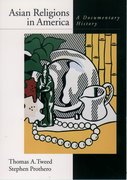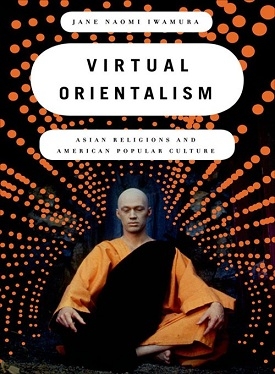Virtual Orientialism: Asian Religions Without the Asians
Paul Harvey
A couple of posts coming up here (falling behind already this semester -- the world rushes on, committee meetings must be attended, papers graded, and our poor little blog gets left ignored in the corner) about new books of interest just reviewed in Choice. I've tried to pick out selections here from works which cover subjects that are receive less attention than one would want both here at the blog and in American religious history more generally (our blog contributor Mike Altman is working on Hinduism in America and knows a lot more about this subject generally than any of the rest of us here, so Mike weigh in here with thoughts that you have!).

The first comes from an author familiar to many of you, Jane Iwamura, whose new book about Asian religions and American popular culture is out. Having grown up on Kung Fu and still able to quote lines from it, I certainly am familiar with the topic of "cultural stereotyping by the media" mentioned in the review below. For that and many other reasons, I look forward to picking this work up soon.
Aside from the review, here's a great short piece by Prof. Iwamura drawing on the book. And if you would like a more in-depth scholarly discussion of the book, here is Rudy Busto's discussion of the book, from a panel discussion at McCormick Theological Seminary last year. Finally, I would remind you of the great selection of primary sources on Asian American religions with Asians in Tweed and Prothero's Asian Religions in America: A Documentary History, still an indispensable primary source compilation.
Aside from the review, here's a great short piece by Prof. Iwamura drawing on the book. And if you would like a more in-depth scholarly discussion of the book, here is Rudy Busto's discussion of the book, from a panel discussion at McCormick Theological Seminary last year. Finally, I would remind you of the great selection of primary sources on Asian American religions with Asians in Tweed and Prothero's Asian Religions in America: A Documentary History, still an indispensable primary source compilation.

| . Virtual orientalism: Asian religions and American popular culture. Oxford, 2011. 214p bibl index afp; ISBN 9780199738601, $99.00; ISBN9780199738618 pbk, $24.95. Reviewed in 2011oct CHOICE. | ||
| Deeply indebted to Edward Said's Orientalism (CH, Apr'79), infused with Jean Baudrillard's conceptions of the hyperreal (Simulacra and Simulation, 1994), and written in the style of Judith Snodgrass's Presenting Japanese Buddhism to the West(CH, Jan'04, 41-2767), this volume more fully develops Iwamura's examination of the "Oriental monk" icon and narrative, which first appeared in Religion and Popular Culture in America, edited by Bruce Forbes and Jeffery Mahan (CH, Oct'00, 38-0893). Iwamura undertakes an analysis of photographic and television images appearing in popular media between 1950 and 1975. Through a close reading of representations of three Oriental monks--D. T. Suzuki, the Maharishi Mahesh Yogi, and Kwai Chang Caine (Kung Fu)--Iwamura (Univ. of Southern California) variously unpacks Americans' unfolding perceptions of the East, the dynamics of cultural consumption and appropriation, and the systematic processes of cultural stereotyping by the media. Easily accessible, this work will interest students of American popular culture, media studies, and Asian American religiosity. Summing Up: Highly recommended. Academic libraries supporting upper-level undergraduates and above. -- M. A. Toole, High Point University And for further information, here's a bit about the work from the book's website: |
Saffron-robed monks and long-haired gurus have become familiar characters on the American popular culture scene. Jane Iwamura examines the contemporary fascination with Eastern spirituality and provides a cultural history of the representation of Asian religions in American mass media. Encounters with monks, gurus, bhikkhus, sages, sifus, healers, and masters from a wide variety of ethnic backgrounds and religious traditions provided initial engagements with Asian spiritual traditions. Virtual Orientalism shows the evolution of these interactions, from direct engagements with specific individuals to mediated relations with a conventionalized icon: the Oriental Monk. Visually and psychically compelling, the Oriental Monk becomes for Americans a ''figure of translation''--a convenient symbol for alternative spiritualities and modes of being. Through the figure of the solitary Monk, who generously and purposefully shares his wisdom with the West, Asian religiosity is made manageable-psychologically, socially, and politically--for popular culture consumption. Iwamura's insightful study shows that though popular engagement with Asian religions in the United States has increased, the fact that much of this has taken virtual form makes stereotypical constructions of "the spiritual East" obdurate and especially difficult to challenge.

Comments